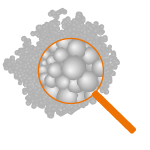Nano definitions
Several definitions are needed to understand what nanoparticles and nanomaterials are. Nanotechnology seeks to explore new material properties in the field of the ultra-small, just above the size of molecules and atoms. The international scientific community has agreed that the scale at which new properties are observed ranges from 1 nm to 100 nm. A nanometer (nm) is one thousandth of a micrometer, or one millionth of a millimeter. Considering the state of current knowledge, this size range cannot be defined exclusively and the definitions are deliberately approximate.
Nanometric scale: Approximately 1 to 100 nm
Nano-object: A material that has one, two or three nanometric scale dimensions
These nano-objects are:
- nanoparticles (3 dimensions on the nanometric scale)
- nano-fibres, nano-tubes or nano-rods (2 dimensions on the nanometric scale)
- nanoplates (1 dimension on the nanometric scale)
Due to their high reactivity, nano-objects tend to group together to form bigger units called aggregates and agglomerates:
- Aggregate: A set of particles composed of strongly linked or bonded particles.
- Agglomerate: A mass of particles (or aggregates, or both) that adhere to each other with weak physical bonds or that are entwined together (as with nanotubes, for example). In this case, the overall external surface area corresponds to the sum of the surface area of its individual components.
It is usual to refer to nano-objects, their aggregates and agglomerates as “nanos”.
The corresponding adjective is nanoparticulate, it corresponds to materials made up of nano-objects, their aggregates and agglomerates.
The term ultrafine particles is also used to refer to nanoparticles (size between 1 and 100 nm) but is mainly used to refer to particles from atmospheric pollution.
The smallest fragment of material with well-defined physical boundaries composing aggregates and agglomerates is called a constituent particle. The smallest fragments of material formed during manufacturing or emission are called primary particles.
Nanoparticles within an aggregate or agglomerate form a structure at nanometric scale. Aggregates and agglomerates of nanoparticles are therefore nanostructured particles.
The term nanomaterial was defined by the International Standards Organisation (ISO) as referring to a single material with an external dimension or a structure on the nanometric scale. In practice it is also used to refer to an assembly of nano-objects (forming a powder for example).
The European Commission clarified this point by qualifying a nanomaterial to be a natural material, formed accidentally or manufactured containing free particles, in the form of aggregates or agglomerates of which at least 50% of the number of constituent particles have multiple external dimensions between 1 nm and 100 nm. By extension, fullerenes, graphene flakes and single-wall carbon nanotubes, even though they have one or more external dimensions of less than 1 nm, should be considered to be nanomaterials.
On the basis of this European Commission definition, France has defined a nanoparticulate substance as being a nanomaterial intentionally manufactured at a nanometric scale.
It should be noted that when in suspension in the air, a nanomaterial will lose its initial consistency, nanostructured particles may become detached from the other particles and move independently.



